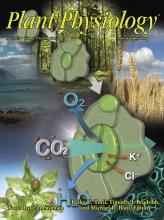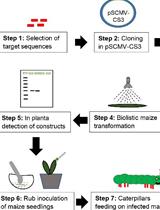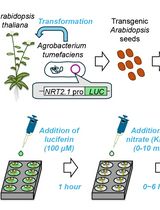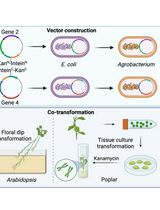- EN - English
- CN - 中文
GUS Staining of Guard Cells to Identify Localised Guard Cell Gene Expression
GUS染色保卫细胞以鉴定保卫细胞中基因的表达
发布: 2017年07月20日第7卷第14期 DOI: 10.21769/BioProtoc.2446 浏览次数: 17938
评审: Scott A M McAdamHonghong WuAnonymous reviewer(s)
Abstract
Determination of a gene expression in guard cells is essential for studying stomatal movements. GUS staining is one means of detecting the localization of a gene expression in guard cells. If a gene is specially expressed in guard cells, the whole cotyledons or rosette leaf can be used for GUS staining. However, if a gene is expressed in both mesophyll and guard cells, it is hard to exhibit a clear expression of the gene in guard cells by a GUS staining image from leaf. To gain a clear guard cell GUS image of small G protein ROP7, a gene expressed in both mesophyll and guard cells, we peeled the epidermal strips from the leaf of 3-4 week-old plants. After removing the mesophyll cells, the epidermal strips were used for GUS staining. We compared the GUS staining images from epidermal strips or leaf of small G protein ROP7 and RopGEF4, a gene specifically expressed in guard cells, and found that GUS staining of epidermal strips provided a good method to show the guard cell expression of a gene expressed in both mesophyll and guard cells. This protocol is applicable for any genes that are expressed in guard cells of Arabidopsis, or other plants that epidermal strips can be easily peeled from the leaf.
Keywords: Guard cells (保卫细胞)Background
Stomatal movements regulate the gas exchange between plants and environment, therefore, it is important to reveal the mechanism of the opening or closure of stomata. Determination of the guard cell expression of a gene is essential for studying its role in stomatal movements. There are several ways to identify the expression of a gene in guard cells. One way is to check the RNA expression of a gene in guard cells by RT-PCR (Jeon et al., 2008; Takimiya et al., 2013). To do so, the protoplasts of mesophyll and guard cells need to be separated. Another way is to check the GUS signal in guard cells of the transgenic plant expressing GUS driven by a gene’s native promoter. In some reports, the evidence of both RNA expression and GUS signal in guard cells were provided (Zheng et al., 2002; Jeon et al., 2008). As for the GUS signal in guard cells, if a gene is specifically expressed in guard cells, like OST1, MYB60, ROP11 and RopGEF4, a distinguished GUS signal in guard cells can be obtained from a GUS staining image with whole leaf (Mustilli et al., 2002; Li et al., 2012; Li and Liu, 2012; Rusconi et al., 2013). However, if a gene is expressed in both mesophyll and guard cells, like ROP10 and RopGEF2, the GUS signal in guard cells is hard to be distinguished from the mesophyll background (Zheng et al., 2002; Li and Liu, 2012). After GUS staining procedure, the leaf will become soft, and it is very difficult to peel the epidermal strips. Therefore, just after the leaf was excised from the plants, we peeled the epidermal strips from the leaf, and the strips were used for GUS staining after the mesophyll cells were removed. By this method, we obtained a clear guard cell GUS image of ROP7, a gene expressed in both mesophyll and guard cells.
Materials and Reagents
- Pipette tips
- 1.5 ml Eppendorf tubes
- Sterilized filter paper
- Plastic Petri dishes for plant culture
- Slide
- Cover glass
- 0.45 micron filter
- Aluminum foil
- Arabidopsis thaliana seeds of ROP7pro:GUS and RopGEF4pro:GUS lines
- 100%, 75%, 40%, 20%, 10%, 5% ethanol in water
- 50% glycerol (Sangon Biotech, catalog number: A100854 )
- 100% methanol
- 37% hydrochloric acid (12 N)
- Sodium hydroxide (AMRESCO, catalog number: 0583 )
- Ethylenediaminetetraacetate acid (EDTA) (AMRESCO, catalog number: 0322 )
- Triton X-100 (AMRESCO, catalog number: 0694 )
- Potassium ferricyanide (AMRESCO, catalog number: 0713 )
- Potassium ferrocyanide (Sigma-Aldrich, catalog number: P9387 )
- X-Gluc (Sigma-Aldrich, catalog number: B5285 )
- Dimethylformamide (AMRESCO, catalog number: 0464 )
- Sodium dihydrogen phosphate (NaH2PO4·H2O) (Sigma-Aldrich, catalog number: S9638 )
- Disodium hydrogen phosphate (Na2HPO4·7H2O) (Sigma-Aldrich, catalog number: 431478 )
- 20% methanol in 0.24 N hydrochloric acid (see Recipes)
- 60% ethanol in 7% sodium hydroxide (see Recipes)
- GUS staining solution (see Recipes)
Equipment
- Pipetman 100 μl (Gilson, catalog number: F123615 )
- Pipetman 1,000 μl (Gilson, catalog number: F123602 )
- Tweezers
- Brush pen
- Plant growth chamber (Percival Scientific, model: CU-36L5 ) and greenhouse
- Pots
- Incubator at 37 °C (SANFA, model: DNP-9052 )
- Microscope (ZEISS, model: Axio Imager A1 )
- Water purification system (deionized water) (EMD Millipore, model: Elix® Essential , 5 L)
Procedure
文章信息
版权信息
© 2017 The Authors; exclusive licensee Bio-protocol LLC.
如何引用
Readers should cite both the Bio-protocol article and the original research article where this protocol was used:
- Liu, Z., Wang, W., Zhang, C., Zhao, J. and Chen, Y. (2017). GUS Staining of Guard Cells to Identify Localised Guard Cell Gene Expression. Bio-protocol 7(14): e2446. DOI: 10.21769/BioProtoc.2446.
- Wang, W., Liu, Z., Bao, L. J., Zhang, S. S., Zhang, C. G., Li, X., Li, H. X., Zhang, X. L., Bones, A. M., Yang, Z. B. and Chen, Y. L. (2017). The RopGEF2-ROP7/ROP2 Pathway Activated by phyB Suppresses Red Light-Induced Stomatal Opening. Plant Physiol 174(2): 717-731.
分类
植物科学 > 植物分子生物学 > DNA > 基因表达
分子生物学 > DNA > 基因表达
您对这篇实验方法有问题吗?
在此处发布您的问题,我们将邀请本文作者来回答。同时,我们会将您的问题发布到Bio-protocol Exchange,以便寻求社区成员的帮助。
提问指南
+ 问题描述
写下详细的问题描述,包括所有有助于他人回答您问题的信息(例如实验过程、条件和相关图像等)。
Share
Bluesky
X
Copy link












